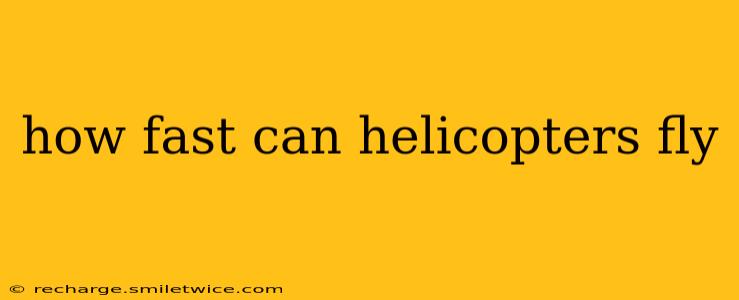How Fast Can Helicopters Fly? A Deep Dive into Helicopter Speed
Helicopters, those marvelously versatile aircraft, are known for their ability to take off and land vertically, hover, and fly backward. But how fast can they actually go? The answer, as with many things, is: it depends. Several factors influence a helicopter's maximum speed, making a simple answer insufficient. Let's explore the nuances of helicopter speed.
What is the average speed of a helicopter?
The average cruising speed of a helicopter varies greatly depending on the model, its size, its payload, and weather conditions. Smaller, lighter helicopters might cruise at speeds around 80-100 knots (92-115 mph), while larger, more powerful models can reach speeds exceeding 150 knots (173 mph). Think of it like comparing a compact car to a luxury SUV – both get you from point A to point B, but their performance and capabilities differ significantly.
What is the fastest helicopter in the world?
Currently, the title of "fastest helicopter in the world" belongs to the Westland Lynx, which has achieved speeds exceeding 245 mph (394 km/h) in specific testing conditions. However, this speed is not typical for operational use. Most helicopters operate at significantly lower speeds for reasons of safety, fuel efficiency, and operational practicality.
What factors affect helicopter speed?
Several key factors significantly impact a helicopter's speed:
- Helicopter Model and Design: Different helicopters have different designs, engines, and rotor systems, all of which affect their potential speed. Larger, more powerful helicopters naturally tend to be faster.
- Payload: The weight carried by the helicopter (passengers, cargo, fuel) directly impacts its speed and maneuverability. A heavier load requires more power, reducing speed.
- Altitude: The thinner air at higher altitudes reduces the lift generated by the rotors, thus reducing the helicopter's maximum speed.
- Weather Conditions: Wind, rain, and temperature all affect the helicopter's performance and speed. Headwinds significantly decrease ground speed, while tailwinds increase it.
- Engine Power: The horsepower of the engine dictates the available power for thrust and lift. More powerful engines allow for greater speed.
What are the different types of helicopter speeds?
It's crucial to understand that "speed" in the context of helicopters often has multiple meanings:
- Maximum Speed (VNE): This is the absolute highest speed the helicopter is designed to achieve. Exceeding this speed can lead to structural damage or failure.
- Cruising Speed: This is the most fuel-efficient speed at which the helicopter can operate for extended periods.
- Never Exceed Speed (VNE): This speed should never be surpassed during operation. It is a critical safety limit.
How does a helicopter's speed compare to other aircraft?
Compared to fixed-wing aircraft like airplanes, helicopters are considerably slower. Airplanes can cruise at speeds several times faster than even the fastest helicopters. However, helicopters’ ability to take off and land vertically, hover, and fly in all directions makes them unparalleled for specific tasks, such as search and rescue, emergency medical services, and construction.
In conclusion, there's no single answer to "how fast can helicopters fly?". The speed depends on numerous factors. While some experimental helicopters have reached impressive speeds, typical operational speeds are significantly lower, reflecting the balance between performance and safety. Understanding these factors provides a clearer picture of the capabilities and limitations of these fascinating machines.
